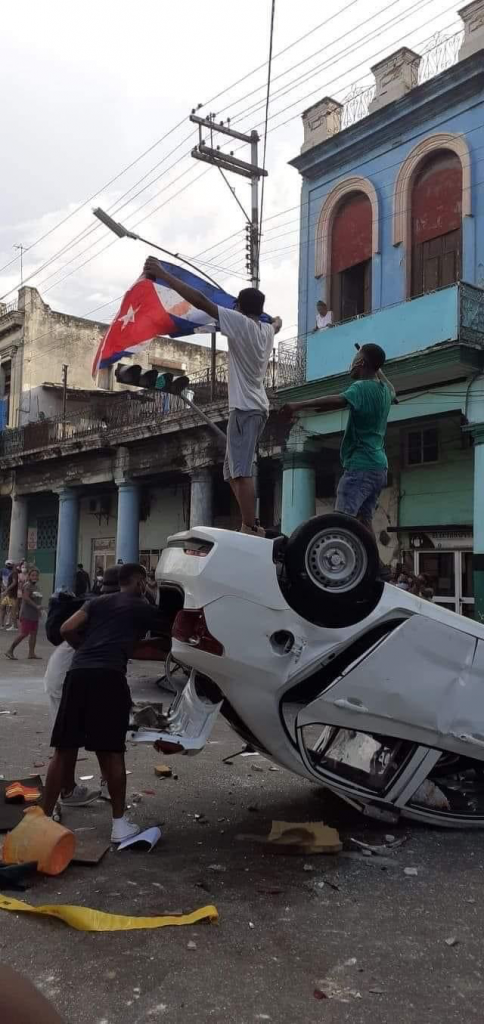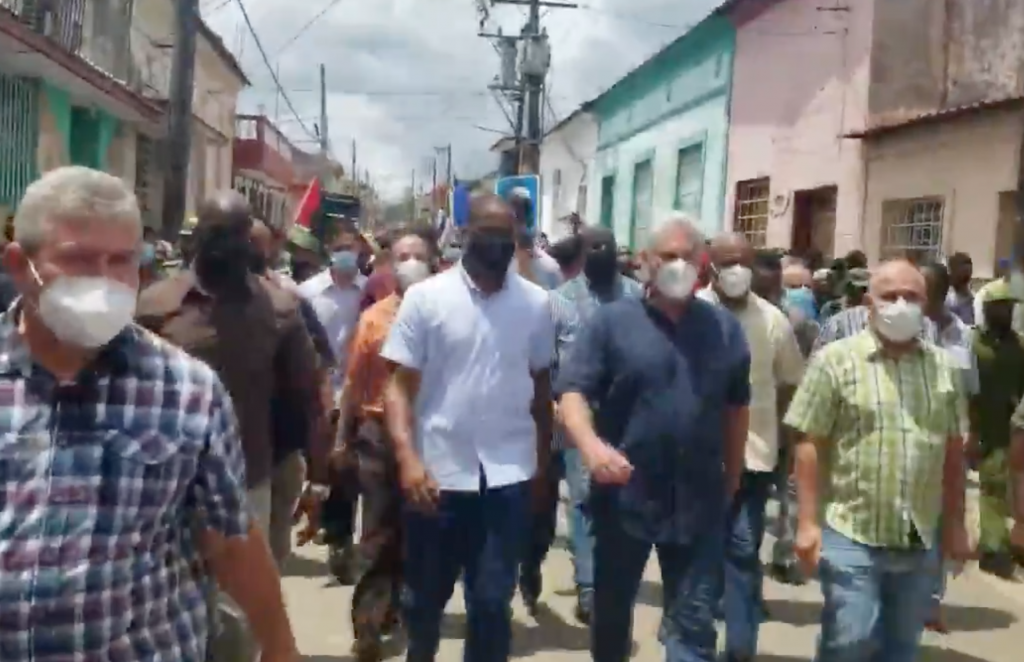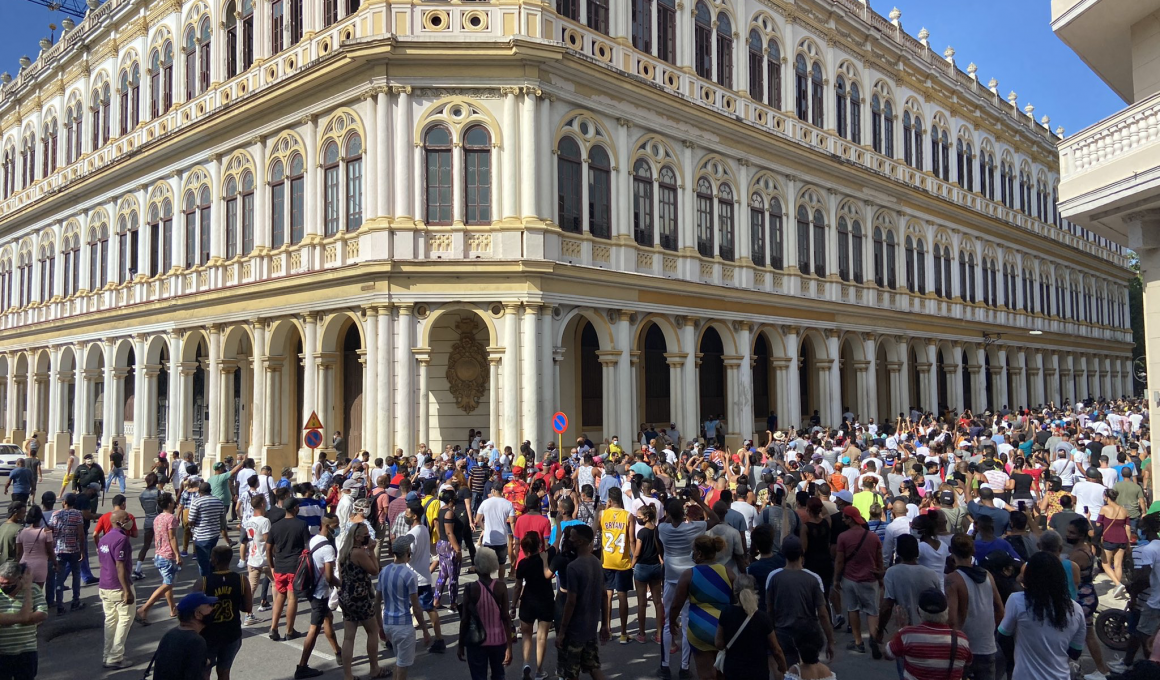
CUBA STANDARD — A wave of protests mobilized thousands of Cubans July 11, prompting President Miguel Díaz-Canel to walk the streets of San Antonio de los Baños, a small town outside Havana where the demonstrations started mid-day, speak about the difficult situation and government efforts to address it, and declare an “order to combat” while reviving the Fidel mantra of “The streets belong to the revolutionaries”.

In Havana, protests and counterprotests began a few hours later, with several thousand people — demonstrators, onlookers, and groups in support of the government — gathering at the Parque de la Fraternidad near the Capitolio, chanting “Díaz-Canel step down” and “Fidel”.
Protesters expressed frustration over shortages, rising prices and rolling blackouts, exploding COVID-19 contagion and late mass vaccination, and chanting “Libertad”, and “Patria y Vida”, referring to a song recently produced in Miami by Cuban artists.
When demonstrators marched down Prado Avenue towards the seaside Malecón, they were blocked by police.
As protests were flaring up in Havana, state television interrupted the live broadcast of the European soccer championship final and regular programming on all channels for an address by the president. Díaz-Canel spoke about the discontent and acknowledged numerous problems. At the same time, he recalled tightened U.S. sanctions, blaming the United States for the grave economic situation and for inciting the protests. He also asked supporters to defend the revolution in the streets: “We call on all revolutionaries, all communists, to take to the streets and go to the places where these provocations are taking place.”
“No provocations will be allowed,” Díaz-Canel said, invoking a famous mantra of Fidel Castro: “The street belongs to the revolutionaries.”
In some video footage, groups of people can be seen overturning police cars, smashing shop windows and looting foreign exchange stores. In the La Lisa neighborhood in Havana, a crowd of several hundred, mostly young protesters threw rocks at police.
There were clusters of pro-government demonstrators, following their president’s call, in several places in Havana, holding posters of Fidel and waving Cuban flags.
Videos posted on social media show protests in Palma Soriano, Holguín, Camagüey, Santiago de Cuba and other places.
Participants and eyewitnesses reported that police and special forces suppressed protests, in part with batons, pepper spray and arrests. Others spoke more of scuffles. The number of arrests could not be independently confirmed; the opposition San Isidro group spoke of 110 missing persons as of Sunday. Various lists of names are circulating, including one with nine filmmakers; most of them have probably been released.

In Centro Habana and Old Havana, numerous special police units and rapid response teams were on the move in the afternoon and evening; the Capitolio was widely cordoned off.
By early evening, the situation had largely calmed down. Due to the pandemic, there are nightly curfews practically in the entire island.
Even so, these were the largest protests in Cuba since the Maleconazo of August 1994, at the height of another profound crisis known as the “Special Period”, when hundreds of people demonstrated on Havana’s waterfront promenade. Unlike in 1994, though, this time the protests had a national dimension — due to social media — that surprised the authorities.
The day after
On Monday, calm had returned — at least in Havana, with massive police presence in some neighborhoods. Mobile Internet remained shut down throughout the day or only worked in short intervals.
It remains unclear how many people were arrested and continue to be detained. Various lists of names are circulating, including one with nine filmmakers, but at least two of them have been released.
On Monday, a man died in the La Güinera neighborhood in Havana during a clash between police and a group of young men that were reportedly on the way to a police station. But altogether, normalcy is back to the streets of Havana, with people walking dogs, standing in line at shops, and children playing soccer.
“There is more police presence than usual, black berets are patrolling the Malecón, and some activists are under house arrest, but this doesn’t look like a state of emergency,” one foreign observer told Cuba Standard.
Government q&a
Monday morning, President Díaz-Canel and cabinet ministers addressed the population again on Cuban television, in a more than four hours long question-and-answer from the Palacio de la Revolucón.
The president accused the United States of “inflaming” the situation in Cuba for months, exploiting popular discontent. He blamed the severe economic and supply crisis on the U.S. blockade policy, “which is trying in a mendacious and cynical way to provoke a regime change in Cuba.”
Washington should lift the blockade, he said, if it is truly interested in the welfare of the Cuban people.
“Let them lift the blockade, and then we’ll see how we play.”
Sunday’s “incidents” were organized by a “small group of counterrevolutionaries,” Díaz-Canel said. He spoke of provocations, but admitted that there were also people with “nonconformities and legitimate claims” in the protests, as well as “confused revolutionaries” who demonstrated because of the hardships on the island.
Regarding his call the day before to take to the streets, Díaz-Canel seemed to walk back his “call to combat”.
“We did not call the people to confront the people,” he said. “We made a call to defend the revolution and its rights, and people supported it. We have not incited anyone from the positions of force or violence.”
He blamed the discontent on the increase in power outages in recent weeks, the lack of medicines and the difficult supply situation.
The Monday appearance was followed by a similarly extensive explanation of current circumstance by the president and prime minister on state TV’s Mesa Redonda show.
Internet and social media
The protest in San Antonio de los Baños does not appear to have been spontaneous. One participant told the BBC the demonstration was organized through social media on Saturday for 11:30 a.m. Sunday. Hundreds of people took to the streets because of long power cuts, but also to demand “freedom” and political change. The protest was broadcast live via Facebook and triggered calls for more demonstrations on the networks.
Videos of street protests in San Antonio de los Baños, Palma Soriano, Holguín, Camagüey, Santiago de Cuba and other places quickly made the rounds on Twitter, Facebook and Instagram, attracting much attention abroad. Expressions of solidarity and calls for “intervention” came from Miami.
State telecom Etecsa shut down the mobile Internet Sunday afternoon. As of July 15, the mobile Internet was up again. However, network data from Internet watchdog NetBlocks.org also confirms targeted disruption to social media and messaging platforms in Cuba since July 12. According to NetBlocks.org, WhatsApp, Facebook, Instagram and as well as some Telegram servers were disrupted on state telecom Etecsa’s Cubacel. The platforms are still accessible via VPN.
Public reactions in Cuba
Several prominent Cubans, including Los Van Van, a popular band that has been a mainstay of the official music scene, and jazz pianist Chucho Valdés, expressed their support for the protesters and urged the government to seek a dialogue.
The Cuban Bishops’ Conference issued a statement that seems to position the Catholic Church as a potential mediator and facilitator. The carefully worded statement credits the government for trying to alleviate problems, supports people’s right to publicly express their grievances, seems to appeal to the government to open up more space for private business, criticizes government immobility and hardening of positions, and calls for dialogue.
“We understand the government has responsibilities, and it has tried to take measures to alleviate the difficulties, but we also understand that people have the right to manifest their needs, dreams and hopes, and publicly express how some measures that have been taken affect them in a serious way,” the statement says. “It is necessary that each person contribute their creativity and initiative, and that each family work for its own wellbeing, knowing that when this happens, it is for the good of the nation.”
Reactions abroad
The U.S. president issued a rather confrontational statement the morning after the protests.
“We stand with the Cuban people and their clarion call for freedom and relief from the tragic grip of the pandemic and from the decades of repression and economic suffering to which they have been subjected by Cuba’s authoritarian regime,” the statement said. “The Cuban people are bravely asserting fundamental and universal rights. Those rights, including the right of peaceful protest and the right to freely determine their own future, must be respected. The United States calls on the Cuban regime to hear their people and serve their needs at this vital moment rather than enriching themselves.”
Biden made similar comments to the press the same day. He did not mention U.S. sanctions.
Asked “would you consider changing the embargo on Cuba”, and “When you will be ready to change Trump’s reversal on Cuba?” all Biden said was, “We are going to have more to say about Cuba as the week goes on — so stay tuned.”
On Monday, the chair of the House Foreign Relations Committee, Rep. Gregory Meeks, joined a call to Biden by Rep. Jim McGovern (D-Mass.) to lift sanctions in response to the protests.
“I call on President Biden to help alleviate the suffering in Cuba by rescinding the Trump era sanctions,” McGovern said Sunday.
A Chinese foreign ministry spokesman on Monday called on the U.S. government to lift sanctions and expressed support for the Cuban government.
The European Union has yet to issue an official statement. Responding to a reporter question Monday, EU High Representative of Foreign Affairs Josep Borrell said, “I want to ask the government to allow these peaceful demonstrations and listen to the discontent of the demonstrators.”
Meanwhile, the Mexican president, Russia and the ALBA bloc focused on foreign intervention in Cuba.
“It has to be the Cubans who decide, because Cuba is a free, independent and sovereign country,” said Andrés Manuel López Obrador, in an apparent swipe at the Biden administration. “There should not be any interventionism. The health situation of the Cuban people should not be used for political ends. That must stay aside.”
“We are confident the Cuban authorities a taking the measures to guarantee public order in the interest of Cuban citizens,” the Russian foreign ministry said in a statement. “We consider external meddling in the internal affairs of a sovereign state unacceptable.”
The regional ALBA bloc accused the United States of “organizing and financing” the protests.

The triggers
COVID contagion and death have set new records almost every day in the past week. On July 10, there were 6,923 new cases and 48 deaths. Responding to an outbreak in Matanzas, 500 medical personnel were sent to that province July 9, plus 200 members of a medical brigade that is usually sent abroad. On July 10, 200 Cuban medics were recalled from Venezuela to be deployed in the island. Mass vaccination began in May with two Cuban-developed vaccines; as of Sunday, 15.5% of the total population was fully vaccinated.
Meanwhile, amid sweltering heat, Energy Minister Nicolás Liván Arronte Cruz asked for “understanding” for rolling blackouts since June 21, saying that efforts to repair breakdowns at several Soviet-era thermoelectric power plants continue uninterrupted. Cuba’s largest, the 300-mw Antonio Guiteras plant at Matanzas, had been offline for several days after a breakdown and was back online Tuesday morning. The 160-mw Felton power plant near Holguín is offline again, after maintenance in late June. State utility Unión Eléctrica postponed planned maintenance for 13 of 19 generators.
The minister blamed “tense limitations for spare parts and technology, fuel for power generation due to blockade-related problems, and fuel quality”. He said more frequent blackouts in the past three days were due to a “considerable rise” in demand for electricity during peak hours.
—Various correspondents contributed to this article

